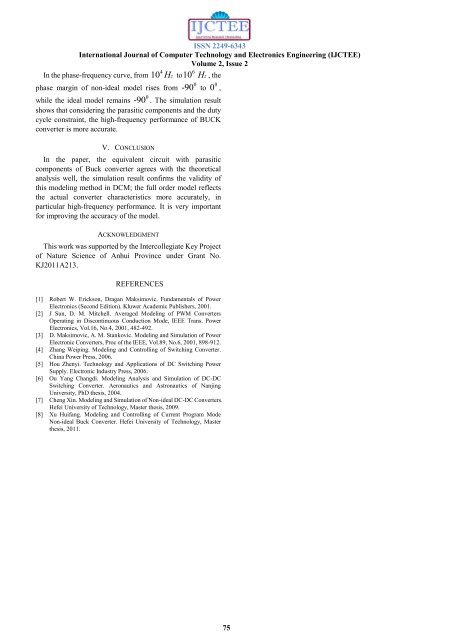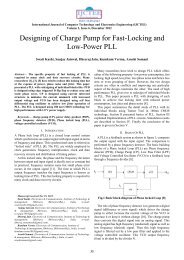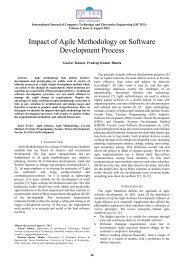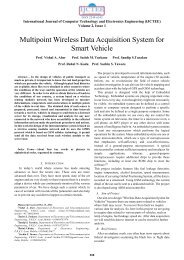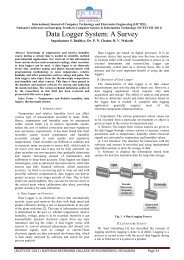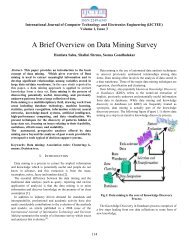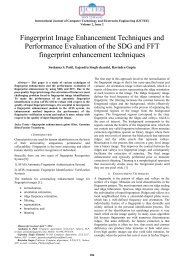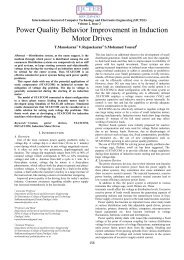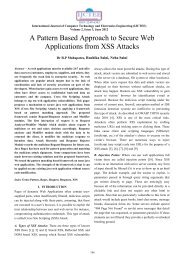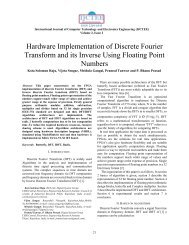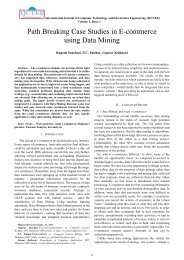Modeling and Simulation of Non-ideal Buck Converter in DCM
Modeling and Simulation of Non-ideal Buck Converter in DCM
Modeling and Simulation of Non-ideal Buck Converter in DCM
You also want an ePaper? Increase the reach of your titles
YUMPU automatically turns print PDFs into web optimized ePapers that Google loves.
ISSN 2249-6343International Journal <strong>of</strong> Computer Technology <strong>and</strong> Electronics Eng<strong>in</strong>eer<strong>in</strong>g (IJCTEE)Volume 2, Issue 246In the phase-frequency curve, from 10 H z to10 H z , the0 0phase marg<strong>in</strong> <strong>of</strong> non-<strong>ideal</strong> model rises from -90 to 0 ,0while the <strong>ideal</strong> model rema<strong>in</strong>s -90 . The simulation resultshows that consider<strong>in</strong>g the parasitic components <strong>and</strong> the dutycycle constra<strong>in</strong>t, the high-frequency performance <strong>of</strong> BUCKconverter is more accurate.V. CONCLUSIONIn the paper, the equivalent circuit with parasiticcomponents <strong>of</strong> <strong>Buck</strong> converter agrees with the theoreticalanalysis well, the simulation result confirms the validity <strong>of</strong>this model<strong>in</strong>g method <strong>in</strong> <strong>DCM</strong>; the full order model reflectsthe actual converter characteristics more accurately, <strong>in</strong>particular high-frequency performance. It is very importantfor improv<strong>in</strong>g the accuracy <strong>of</strong> the model.ACKNOWLEDGMENTThis work was supported by the Intercollegiate Key Project<strong>of</strong> Nature Science <strong>of</strong> Anhui Prov<strong>in</strong>ce under Grant No.KJ2011A213.REFERENCES[1] Robert W. Erickson, Dragan Maksimovic. Fundamentals <strong>of</strong> PowerElectronics (Second Edition). Kluwer Academic Publishers, 2001.[2] J Sun, D. M. Mitchell. Averaged <strong>Model<strong>in</strong>g</strong> <strong>of</strong> PWM <strong>Converter</strong>sOperat<strong>in</strong>g <strong>in</strong> Discont<strong>in</strong>uous Conduction Mode, IEEE Trans. PowerElectronics, Vol.16, No.4, 2001, 482-492.[3] D. Maksimovic, A. M. Stankovic. <strong>Model<strong>in</strong>g</strong> <strong>and</strong> <strong>Simulation</strong> <strong>of</strong> PowerElectronic <strong>Converter</strong>s, Proc <strong>of</strong> the IEEE, Vol.89, No.6, 2001, 898-912.[4] Zhang Weip<strong>in</strong>g. <strong>Model<strong>in</strong>g</strong> <strong>and</strong> Controll<strong>in</strong>g <strong>of</strong> Switch<strong>in</strong>g <strong>Converter</strong>.Ch<strong>in</strong>a Power Press, 2006.[5] Hou Zhenyi. Technology <strong>and</strong> Applications <strong>of</strong> DC Switch<strong>in</strong>g PowerSupply. Electronic Industry Press, 2006.[6] Ou Yang Changdi. <strong>Model<strong>in</strong>g</strong> Analysis <strong>and</strong> <strong>Simulation</strong> <strong>of</strong> DC-DCSwitch<strong>in</strong>g <strong>Converter</strong>. Aeronautics <strong>and</strong> Astronautics <strong>of</strong> Nanj<strong>in</strong>gUniversity, PhD thesis, 2004.[7] Cheng X<strong>in</strong>. <strong>Model<strong>in</strong>g</strong> <strong>and</strong> <strong>Simulation</strong> <strong>of</strong> <strong>Non</strong>-<strong>ideal</strong> DC-DC <strong>Converter</strong>s.Hefei University <strong>of</strong> Technology, Master thesis, 2009.[8] Xu Huifang. <strong>Model<strong>in</strong>g</strong> <strong>and</strong> Controll<strong>in</strong>g <strong>of</strong> Current Program Mode<strong>Non</strong>-<strong>ideal</strong> <strong>Buck</strong> <strong>Converter</strong>. Hefei University <strong>of</strong> Technology, Masterthesis, 2011.75


